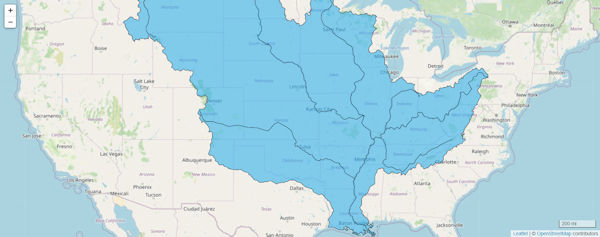SEJournal Online is the digital news magazine of the Society of Environmental Journalists. Learn more about SEJournal Online, including submission, subscription and advertising information.
 |
| The Mississippi River Basin stretches from just north of the Canada-U.S. border to the Gulf of Mexico, as shown in the map above. Image: Mississippi River Basin Ag & Water Desk. Click to enlarge. |
Feature: New Reporting Network Aims To Make Connections in the Mississippi Basin
By Tegan Wendland
Every spring in the Gulf south we hold our breath as we watch the Mississippi River rise, bulging as it laps against the tall cement and earthen levees that were built to hold it back.
From Cape Girardeau, Missouri, all the way down to New Orleans, gauges measure how many feet above normal the dark, murky water has risen each day and warn of how many more feet it might take to overtop levees. A collective anxiety hangs in the air, tinged by sepia-toned memories of the flood of 1927, when whole towns and cities in the Lower Mississippi River Basin were swept away.
This annual fear is just a rhythm of life along the lower Mississippi, although of course today the U.S. Army Corps of Engineers can open up spillways when the river is high, diverting water and protecting major cities. And they’ve been doing so almost yearly over the past decade, as heavier precipitation in the Upper Mississippi River Basin increases runoff, raising the threat of flooding.
But there’s a disconnect in how journalists usually tell this story. Daily coverage reports on the latest river gauge readings and the latest status updates from the Army Corps’ local office. Very little is said about how climate change is bringing heavier snowfall and record-breaking rainfall up north, which — exacerbated by erosion and monocropping — is increasing the amount of water that makes its way into the Mississippi River and ultimately to the Gulf of Mexico.
Floodwaters do not know state boundaries
and we’re holding ourselves back by limiting
our coverage to the city and state lines
that define traditional news markets.
That’s just one example of how news coverage can amplify the disconnect in the Mississippi River Basin. Floodwaters do not know state boundaries, and we’re holding ourselves back by limiting our coverage to the city and state lines that define traditional news markets. The Mississippi River Basin Ag & Water Desk is trying to solve that problem.
Launched in the summer of 2021 as a partnership between the Missouri School of Journalism, Report for America and the Society of Environmental Journalists, this initiative is a sustainable reporting network aimed at telling water and agriculture stories across the basin. With 10 environmental reporters based in newsrooms throughout the basin, our goal is to enhance the quantity, quality and impact of journalism on agriculture and water issues.
The journalistic disconnect
The fourth-largest river system in the world, the Mississippi River and its tributaries provide drainage for 32 states, representing about 40% of the continental United States, and two Canadian provinces. The river is a huge economic driver, with 92% of the nation's agricultural exports, and 78% of the world's exports in feed grains and soybeans being produced within the basin.
The Mississippi also provides fresh drinking water to millions of people. Conversely, it serves as a dumping ground for much of the nation’s industry, and the discharge of many cities’ industrial and municipal waste.
 |
| Author Tegan Wendland. |
Before I was hired as editor of this new desk, I covered environmental issues in Louisiana for many years. During that time I became familiar with the journalistic disconnect between the upper and lower parts of the basin.
Annual flooding is one instance; another is when the Mississippi River/Gulf of Mexico Hypoxia Task Force releases its annual forecast for the “dead zone,” the low-oxygen area in the Gulf of Mexico that causes huge algal blooms and makes the water unlivable for most sea creatures.
The dead zone is largely caused by fertilizer runoff from the Midwest. The more nitrogen fertilizer farmers spread, the bigger the dead zone is. This story illustrates the integral relationship between ecological issues in Middle America and the mouth of the mighty Mississippi. And yet there has been no mechanism for actually connecting those issues and reporting them for audiences throughout the basin.
When I worked as the news editor for the NPR station in New Orleans, we once reached out to St. Louis Public Radio and reported a short series connecting farming practices in the Midwest with fishing industry struggles on the Gulf coast. It was a one-off project that required planning, coordination and joint-editing between two public radio stations, and then only aired in their respective markets.
The Times-Picayune | The New Orleans Advocate reporter Tristan Baurick wrote a special series in 2019 detailing the history of flood mitigation and river engineering, but again, this was a discrete series that was published only by one local outlet.
Other than national coverage, this has been the standard approach for news outlets in the basin. Up until now.
A bioregional approach to news markets
Modeled after regional and local journalism collaborations that have come before it, the Mississippi River Basin Ag & Water Desk aims to help outlets throughout the basin rethink what constitutes a “news market.”
By defining our market as a bioregion, we hope to be able to do more relevant, wide-ranging reporting that contextualizes issues like flooding, agriculture, river engineering, shipping, runoff, industrial pollution, environmental injustices and other issues for the roughly 70 million people who live in the basin.
And then we’re going to give it away. The content produced by the desk will be offered, free-of-charge, to any news outlet that wants to carry it. We hope that in doing so we are able to assist struggling news outlets in covering underreported environmental issues that are salient to their audiences.
We also hope to reach diverse audiences in rural areas who might not otherwise be exposed to stories about the impacts of climate change, ecological solutions to flooding or alternative agricultural practices that reduce nutrient runoff.
We’re not the first to conceive of a bioregion as a community. In 1870, American geologist and western expansionist John Wesley Powell proposed a radical new map: one that defined western states by watersheds rather than arbitrary state lines. And geography has always been part of how Native American societies define themselves. In this era of climate change, such bioregional thinking is an idea worth revisiting.
Making connections to counter isolation, empower citizens
Having grown up in Wisconsin on a rural farm in the middle of nowhere, I witnessed firsthand the shift away from family farming to large-scale industrial agriculture when the woods surrounding my mother’s farm were clear-cut for corn and soybean fields. I saw small dairy farms shut down and a big animal feedlot start up a few towns over. That operation was recently charged with dumping manure into two local streams. Local news coverage did not discuss the impacts downstream and community members didn’t talk about it.
These felt like small, isolated local stories. They made all of the difference in the lives of many in my rural hometown community, but the siloed news environment left them feeling alone in facing the magnitude of environmental degradation and climatic change.
Living in the Deep South for the past decade, I can tell you that it feels exactly the same way here when the river rises or we face rebuilding after yet another flood.
The Mississippi River touches so many lives.
We hope that in connecting these stories,
this project will make people feel less alone.
The Mississippi River touches so many lives. We hope that in connecting these stories, this project will make people feel less alone. We want to help citizens understand the basin as an interconnected system and empower them to make decisions — whether that’s changing their farming practices or electing city officials who advocate for cleaner water practices — that benefit us all.
If you want to learn more, a good way to start is with this Mississippi River reading list:
- “Life on the Mississippi,” Mark Twain, James R. Osgood and Company, 1883
- “Up on the River: People and Wildlife of the Upper Mississippi,” John Madson, University of Iowa Press, 1985
- “Atchafalaya,” John McPhee, The New Yorker, 1987
- “Rising Tide: The Great Mississippi Flood of 1927 and How It Changed America,” John M. Barry, Simon & Schuster, 1998
- “Immortal River: The Upper Mississippi in Ancient and Modern Times,” Calvin Fremling, The University of Wisconsin Press, 2004
- “The River We Have Wrought: A History of the Upper Mississippi,” John O. Anfinson, University of Minnesota Press, 2005
- “Black Life on the Mississippi: Slaves, Free Blacks, and the Western Steamboat World,” Thomas C. Buchanan, The University of North Carolina Press, 2006
- “Cahokia: Ancient America’s Great City on the Mississippi,” Timothy R. Pauketat, Penguin Random House, 2010
- “Wicked River: The Mississippi When It Last Ran Wild,” Lee Sandlin, Penguin Random House, 2011
- “Old Man River: The Mississippi River in North American History,” Paul Schneider, Macmillan Publishers, 2013
Mississippi River Basin Ag & Water Desk Editorial Director Tegan Wendland has more than a decade of experience reporting on issues in the Mississippi River Basin, from the shores of Lake Superior to the Louisiana Delta. Her work has aired nationally and internationally on Morning Edition, All Things Considered, Marketplace, Planet Money, Reveal, BBC and CBC, and has been published in the Wisconsin Journal Sentinel, Wisconsin State Journal, Cap Times and The Times-Picayune | The New Orleans Advocate, among other print and radio outlets. For the past seven years, she reported on Louisiana’s disappearing coast for NPR station WWNO in New Orleans. To carry Mississippi River Basin Ag & Water Desk coverage, email the team at info@agwaterdesk.org.
* From the weekly news magazine SEJournal Online, Vol. 6, No. 44. Content from each new issue of SEJournal Online is available to the public via the SEJournal Online main page. Subscribe to the e-newsletter here. And see past issues of the SEJournal archived here.














 Advertisement
Advertisement 



